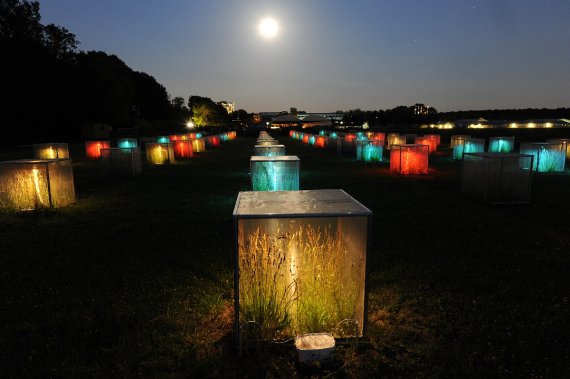*A*nywone driving along the Bornsesteeg at night in the next few weeks will hardly be able to ignore the red, white and green lights scattered around a site behind the campus. They are not for a party – this is pure science. This is where the ecologist Koert van Geffen is trying to figure out whether moths are adversely affected by artificial light, and if so, how and what consequences this has for vegetation.
Roadside
There are a total of eighty cages lined up in fighting order, each a cubic metre in volume and covered with netting. With the exception of the control cages, each cage contains a green, red or white LED lamp specially designed for this purpose by Philips. The lights simulate the street lighting along the average Dutch rural road. The cages house the caterpillars of cabbage moths and/or feathered ear moths, two examples of the wide assortment of more than 1,200 moths to be found in the Netherlands. The cages also contain a biotope of eight different species of plants: four grasses and four herbs. ‘Velvet grass, for example, and sorrel, knapweed and daisies. The standard plants you would find in a well-developed roadside’, explains Van Geffen.
Prison
The caterpillars (and eventually the moths) are really being kept in a kind of luxury prison. You have enough to eat and there is nothing that will eat you because you’re safe behind the netting. There are no problems on the sex front either. But there is one disadvantage: the lack of privacy. The lights disrupt the darkness they normally cherish. ‘Of course it’s an unnatural situation to put a caterpillar under a lamp and stop it from getting away’, acknowledges Van Geffen. ‘But this is the best available option if you want to study the effect of artificial light.’
Counting and measuring
Over the next few years Van Geffen will be meticulously analyzing the effect of the light on the caterpillars, moths and vegetation. For little is known about this at present. Moths are attracted to light, which makes them easy prey for bats. The light disrupts their feeding and mating behaviour. But does that result in fewer caterpillars? Are some species more affected than others? And does it have a noticeable effect on the vegetation? After all, caterpillars are important herbivores. The only way to answer these questions is to count and measure. ‘Keeping track of the moth population, counting caterpillars, and cutting off and weighing the vegetation in the autumn’, explains Van Geffen. Which is a lot of work. ‘Eighty plants per cage and each sprig has to be put in the right container. It takes weeks.’ Van Geffen speaks from experience: last November he carried out the baseline measurement of the vegetation.
Pheromones
Van Geffen’s experiment is part of the Spotlight on Nature project. In this project, various researchers are investigating the effect of artificial light on flora and fauna. For example, researchers at the University of Amsterdam are focusing on the reproduction of cabbage moths by looking at the effect of artificial light on the production of pheromones (sex attractants). An extensive experiment with lights started earlier this year in the Veluwe. Here, Wageningen researchers are looking at the impact of light on the entire range of flora and fauna. In all cases they are using the same light that Van Geffen is using. The idea is that the project results will lead to the introduction of lighting that is more nature friendly.

